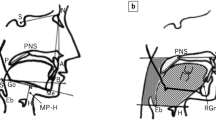Abstract
Computed tomography (CT) has become a common method for evaluating obstructive sleep apnea (OSA). The aim of this study was to analyze the relationships between CT parameters and clinical parameters in OSA patients to determine major factors affecting the severity of OSA. The records of 128 consecutive snoring patients (98 males, 30 females) diagnosed with OSA were retrospectively reviewed. Polysomnography was performed for each patient. On CT scans, airway areas were measured at the level of the hard palate, the soft palate, and the base of the tongue. Polysomnographic parameters were compared by gender and age using the Mann–Whitney U test. Pearson’s correlation coefficient was used to analyze relationships between variables and the AHI in each age group. The women were significantly older than the men (p < 0.01). The AHI and apnea index were significantly higher in men than in women. Stage 1 sleep and rapid eye movement sleep were more frequent in men than in women. The area at the base of the tongue was significantly smaller in women than in men (p = 0.027). In the 50–60 age group, the AHI was significantly higher in men (41.47 ± 19.67) than in women (17.14 ± 15.63) (p = 0.001). OSA severity varies with age, gender, and upper airway area. The OSA prognosis could be improved by evaluating the major factors and treating OSA patients according to epidemiological characteristics and anatomical structures.



Similar content being viewed by others
References
Young T, Palata M, Dempsey J, Skatrud J, Weber S, Badr S (1993) The occurrence of sleep-disordered breathing among middle-aged adults. N Engl J Med 328:1230–1235
Subramanian S, Hesselbacher S, Mattewal A, Surani S (2013) Gender and age influence the effects of slow-wave sleep on respiration in patients with obstructive sleep apnea. Sleep Breath 17:51–56
Wahner-Roedler EL, Olson EJ, Narayanan S, Sood R, Hanson AC, Loehrer LL et al (2007) Gender-specific differences in a patient population with obstructive sleep apnea-hypopnea syndrome. Gend Med 4(4):329–338
Gabbay IE, Lavie P (2012) Age- and gender-related characteristics of obstructive sleep apnea. Sleep Breath 16:453–460
White DP (2005) Pathogenesis of obstructive and central sleep apnea. Am J Respir Crit Care Med 172:1363–1370
Young T, Peppard P, Gottlieb D (2002) The epidemiology of obstructive sleep apena: a population health perspective. Am J Respir Crit Care Med 165:1217–1239
Weissman MM, Greenwald S, Nino-Murcia G, Dement WC (1997) The morbidity of insomnia uncomplicated by psychiatric disorders. Gen Hosp Psychiatry 19:245–250
Leproult R, Copinschi G, Buxton O, Dement WC (1997) Sleep loss results in an elevation of cortisol levels the next evening. Sleep 20:865–870
Wingard DL, Berkman LF (1983) Mortality risk associated with sleeping patterns smong adults. Sleep 6:102–107
Lavie P, Herer P, Peled R, Berger I, Yoffe N, Zomer J et al (1995) Mortality in sleep apnea patients: a multivariate analysis of risk factor. Sleep 18:149–157
Ayalon L, Liu L, Ancoli-Israel S (2004) Diagnosing and treating sleep disorders in the older adult. Med Clin North Am 88(3):737–750
Dencey DR, Hanly PJ, Soong C, Lee B, Shepard J Jr, Hoffstein V (2003) Gender differences in sleep apnea. Chest 123:1544–1550
Millman RP, Carlisle CC, McGarvey ST, Eveloff SE, Levinson PD (1995) Body fat distribution and sleep apnea severity in women. Chest 107:362–366
Pillar G, Malhotra A, Fogel R, Beaureqard J, Schnall R, White DP (2000) Airway mechanics and ventilation in response to resistive loading during sleep: influence of gender. Am J Respir Crit Care Med 162:1627–1632
Schellenberg JB, Maislin G, Schwab RJ (2000) Physical findings and the risk for obstructive sleep apena. The importance of oropharyngeal structures. Am J Respir Crit Care Med 162:740–748
Dancey DR, Hanly PJ, Soong C, Lee B, Hoffstein V (2001) Impact of menopause on the prevalence and severity of sleep apnea. Chest 120:151–155
Tishler PV, Larkin EK, Schluchter MD, Redline S (2003) Incidence of sleep-disordered breathing in an urban adult population: the relative importance of risk factors in the development of sleep-disordered breathing. JAMA:2230–2237
Bixler EO, Vgontzas AN, Lin HM, Ten Have T, Rein J, Vela-Bueno A et al (2001) Prevelence of sleep-disordered breathing in women: effects of gender. Am J Respir Crit Care Med 163:608–613
(1999) Sleep-related breathing disorders in adults: recommendations for syndrome definition and measurement techniques in clinical research. The Report of an American Academy of sleep Medicine Task Force. Sleep 22(5):667–689
Mamikoglu B, Houser S, Akbar I, Ng B, Corey JP (2000) Acoustic rhinometry and computed tomography scans for the diagnosis of nasal septal deviation, with clinical correlation. Otolaryngol Head Neck Surg 123:61–68
Berenholz L, Kesseler A, Lapinsky J, Segal S, Shlamkovitch N (2000) Nasal obstruction in adult: is CT scan of the sinuses necessary? Rhinol 38:181–184
Sforza E, Chouchou F, Collet P, Pichot V, Barthélémy JC, Roche F (2011) Sex differences in obstructive sleep apnoea in an elderly French population. Eur Respir J 37:1137–1143
Subramanian S, Javaraman G, Majid H, Aquilar R, Surani S (2012) Influence of gender and anthropometric measures on severity of obstructive sleep apnea. Sleep Breath 16:1091–1095
Conflict of interest
The authors have no financial disclosures.
Author information
Authors and Affiliations
Corresponding author
Rights and permissions
About this article
Cite this article
Kim, S.W., Kim, BY., Han, J.J. et al. Major Factors Affecting Severity of Obstructive Sleep Apnea. Indian J Otolaryngol Head Neck Surg 67 (Suppl 1), 114–118 (2015). https://doi.org/10.1007/s12070-014-0793-4
Received:
Accepted:
Published:
Issue Date:
DOI: https://doi.org/10.1007/s12070-014-0793-4




